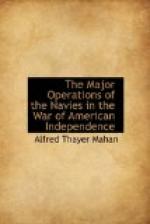[Illustration]
The British fleet tacking in succession after their leaders, (t, t), the immediate result was that both were now standing on the starboard tack,—to the eastward,—the British having a slight advantage of the wind, but well abaft the beam of the French (bb, bb). The result, had the wind held, would have been a trial of speed and weatherliness. “His Majesty’s fleet,” wrote Rodney, “by this manoeuvre had gained the wind, and would have forced the enemy to battle, had it not at once changed six points (back to east, its former direction,) when near the enemy, and enabled them to recover that advantage.” When the wind thus shifted again, de Guichen tacked his ships together and stood across the bows of the advancing enemy (cc, cc). The British leader struck the French line behind the centre, and ran along to leeward, the British van exchanging a close cannonade with the enemy’s rear. Such an engagement, two lines passing on opposite tacks, is usually indecisive, even when the entire fleets are engaged, as at Ushant; but where, as in this case, the engagement is but partial, the result is naturally less. The French van and centre, having passed the head of the enemy, diverged at that point farther and farther from the track of the on-coming British ships, which from the centre rearwards did not fire. “As the enemy were under a press of sail, none but the van of our fleet could come in for any part of the action without wasting his Majesty’s powder and shot, the enemy wantonly expending theirs at such a distance as to have no effect.” Here again the French were evidently taking the chance of disabling the distant enemy in his spars. The British loss in the action of May 15th was 21 killed and 100 wounded.
[Illustration]
The fleets continued their respective movements, each acting as before, until the 19th, when another encounter took place, of exactly the same character as the last, although without the same preliminary manoeuvring. On that occasion the British, who in the interim had been reinforced by one 74 and one 50-gun ship, lost 47 killed and 113 wounded. The result was equally indecisive, tactically considered; but both by this time had exhausted their staying powers. The French, having been absent from Martinique since the 13th of April, had now but six days’ provisions.[88] Rodney found the Conqueror, Cornwall, and Boyne so shattered that he sent them before the wind to Santa Lucia, while he himself with the rest of the fleet stood for Barbados, where he arrived on the 22d. The French anchored on the same day at Fort Royal. “The English,” says Chevalier, “stood on upon the starboard tack, to the southward, after the action of the 19th, and the next day were not to be seen.” “The enemy,” reported Rodney, “stood to the northward with all the sail they could possibly press, and were out of sight the 21st inst. The condition of his Majesty’s ships was such as not to allow a longer pursuit.”




